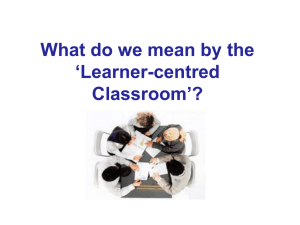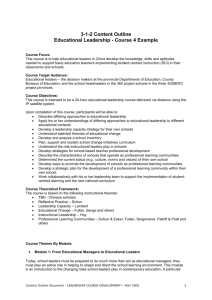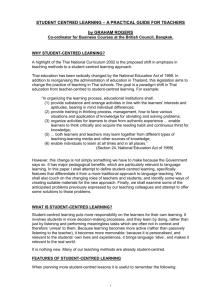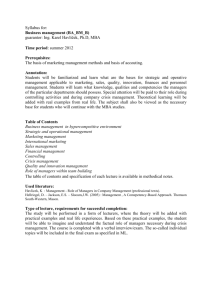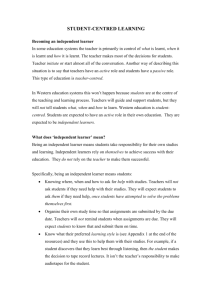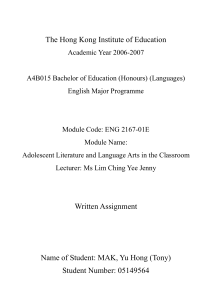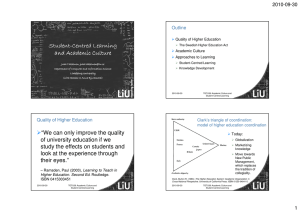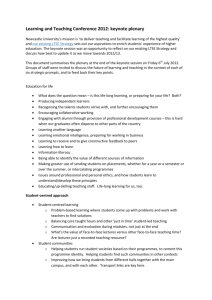6th Pacific Rim First Year in HE Conference
advertisement
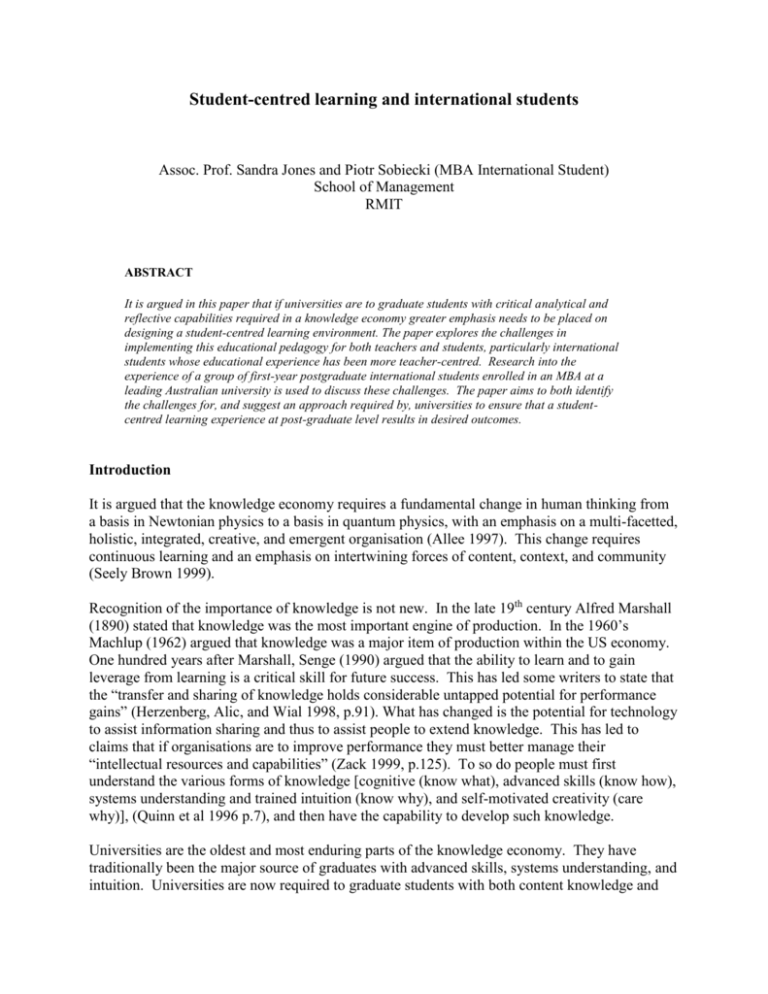
Student-centred learning and international students Assoc. Prof. Sandra Jones and Piotr Sobiecki (MBA International Student) School of Management RMIT ABSTRACT It is argued in this paper that if universities are to graduate students with critical analytical and reflective capabilities required in a knowledge economy greater emphasis needs to be placed on designing a student-centred learning environment. The paper explores the challenges in implementing this educational pedagogy for both teachers and students, particularly international students whose educational experience has been more teacher-centred. Research into the experience of a group of first-year postgraduate international students enrolled in an MBA at a leading Australian university is used to discuss these challenges. The paper aims to both identify the challenges for, and suggest an approach required by, universities to ensure that a studentcentred learning experience at post-graduate level results in desired outcomes. Introduction It is argued that the knowledge economy requires a fundamental change in human thinking from a basis in Newtonian physics to a basis in quantum physics, with an emphasis on a multi-facetted, holistic, integrated, creative, and emergent organisation (Allee 1997). This change requires continuous learning and an emphasis on intertwining forces of content, context, and community (Seely Brown 1999). Recognition of the importance of knowledge is not new. In the late 19th century Alfred Marshall (1890) stated that knowledge was the most important engine of production. In the 1960’s Machlup (1962) argued that knowledge was a major item of production within the US economy. One hundred years after Marshall, Senge (1990) argued that the ability to learn and to gain leverage from learning is a critical skill for future success. This has led some writers to state that the “transfer and sharing of knowledge holds considerable untapped potential for performance gains” (Herzenberg, Alic, and Wial 1998, p.91). What has changed is the potential for technology to assist information sharing and thus to assist people to extend knowledge. This has led to claims that if organisations are to improve performance they must better manage their “intellectual resources and capabilities” (Zack 1999, p.125). To so do people must first understand the various forms of knowledge [cognitive (know what), advanced skills (know how), systems understanding and trained intuition (know why), and self-motivated creativity (care why)], (Quinn et al 1996 p.7), and then have the capability to develop such knowledge. Universities are the oldest and most enduring parts of the knowledge economy. They have traditionally been the major source of graduates with advanced skills, systems understanding, and intuition. Universities are now required to graduate students with both content knowledge and skills. Graduates require the capacity to inspire others in order to “extract information from those who have it, put it in a structured form, and maintain and refine it over time” (Davenport & Prusak 1998, p.129). They need to be willing to engage continuously in learning cycles of doing, reflecting, conceptualising and planning (Senate Committee Report 2001, p.13). At the same time, students are demanding greater quality from the educational process, greater flexibility through ‘virtual’ educational opportunities, and a more student-centred approach that recognises the capabilities that they have developed though experience (Nunan 1999). Biggs summarises this in the following statement: “when the basic bodies of knowledge and knowledge relating to professional practice, are changing as rapidly as they are, it no longer makes sense to teach students all those things they will need to know in their professional careers….Students should be taught how to learn, how to seek new information, how to utilize it and evaluate its importance, how to solve novel, non-textbook, professional problems. They will need metacognitive skills, and an abstract body of theory on which to deploy them, so that they can judge reflectively how successfully they are coping with novel problems, and how they may do better” (Biggs 1999, p.90). In order to achieve this outcome a student-centred rather than a teacher-centred educational pedagogy is required. The next section explores this pedagogy. Student Centred Educational Pedagogy Laurillard (1994) provides a model of a student-centred teaching model (see Figure 1). This model recognises first, that there is a role for the teacher to present students with their conceptual knowledge (content knowledge and generic capabilities), constructed from the teacher’s perspective, and then reflect on the students’ performance. Second, students are encouraged to contribute their own conceptual and experiential knowledge and to reflect upon and adapt their actions accordingly. The link between the two occurs through discussion and interaction between teacher and student. The teacher becomes a guide, coach, motivator, facilitator and co-ordinator of learning resources creating a “context of learning which encourages students actively to engage in subject matter” (Ramsden 1992, p.114). On the other hand the student becomes an active ‘doer’, presenting, analysing, questioning, judging, and combining ideas and information against an argument in order to solve problems and construct ways to develop knowledge (Ballard & Clanchy 1997). Subject matter becomes integrated across a broad range of disciplines, and students work both individually and as a team to collect and assess information to solve problems. Figure 1 Student-Centred Teaching Model 2 Various changes to learning activities and the form of assessment are required for a studentcentred learning approach. First, action-based learning and research can be used to encourage students to observe and reflect upon real-world experiences. Students can then analyse these experiences as abstract concepts and generalisations against documented research, and undertake active experimentation in the concepts under discussion [see the Kolb model of experiential learning], (Kolb, Rubin, McIntyre1971, p.xii; Cherry 1999). Second, experiential exercises such as case-studies, role plays, and real-world events presented through film and video, can be introduced to assist students to analyse and reflect upon events in which they have not directly participated (Jones 1999; 2000). Third, group activities can develop networking between students to encourage consideration of different viewpoints and perspectives and broaden understanding of events in which their peers have participated. Through these group activities students’ ability to derive their own standards for judging better and worse interpretations is developed (Collier 1983; Johnson & Johnson 1990; Topping 1996; Biggs 1999). Biggs quotes Abercrombie as stating, “the metacognitive aspects are sharpened because students readily identify with each other’s learning in a way they do not with top-down teacher-directed learning” (Biggs 1999, p.87). Fourth, there are individual, self-controlled activities, aimed at developing in-depth understanding, monitoring and self-assessment, leading to independent learning (Biggs 1999). Participation in a student-centred learning approach has, however, challenges for teachers and students used to a teacher-centred learning pedagogy. On the one hand, the traditional role of academics teaching in universities has been founded on a liberal tradition of acquiring and disseminating knowledge for its own sake and for the benefits to the community (Miller 1999). Changing this role to one more directly linked to the needs of the global knowledge industry in which the practical experience of students is recognised and celebrated, is difficult. Duderstadt describes this succinctly in his statement: “although the primary mission of the university – the creation, preservation, integration, transmission, and application of knowledge — is not changing, the particular realization of each of these roles is changing dramatically. So, too, is the nature of the higher education enterprise as it evolves into a global knowledge industry” (Duderstadt 1998, p.1) On the other hand, asking students in their first year of post-secondary education or students returning as mature-aged students, to take more responsibility for their learning when their expectation of the learning process is based on a remembered teacher-centred model is also difficult. The challenges are compounded for mature-aged post-graduate students who have attained a level of respect in their own organisation. For these students not only have they to accept a loss of status as they return to student status, but they are then subjected to a learning experience that asks them to reflect upon and analyse their practice. This can confront them with 3 challenges to their values and comfort zones that they had not contemplated. Yet further difficulties are presented for post-graduate international students (IS) who, especially in their first year, face not only language and cultural challenges, but also new learning challenges from the student-centred learning environment (Ballard & Clanchy 1997, p.viii). It is this last challenge – that facing mature-aged post-graduate international students in their first year university experience of a student-centred learning approach - that provides the material this paper. Before identifying how universities may help these students to adjust to, and benefit from, a studentcentred learning environment, it is necessary to consider in more detail the multiple challenges facing international students. International Students and Student-Centred Learning Approach Biggs defines IS as “students who have gone to another country in order to enrol full-time in a university course” (Biggs 1999, p.121). In Australian universities most international students come from Asian countries on the Pacific Rim (Biggs 1999, p.121). These students not only have English language problems to contend with, but more importantly, a new culture to adjust to. In this setting, adapting to a student-centred educational process adds a further burden as students’ educational cultures clash. Biggs states that many Asian cultures, especially those stepped in a rich Confucian educational heritage, place greater emphasis on a conserving approach rather than an extending approach to knowledge (Biggs 1999, p.131-2). Ballard and Clanchy state in Asian cultures “scholarship is traditionally manifested by an extensive and accurate knowledge of the wisdom contained in authoritative texts or the sayings of earlier scholars and sages” (Ballard and Clanchy 1997, p.14). Tyson describes the traditional Asian educational process as based on, and perpetuating, a “culture of dependent learners in a didactic, knowledge-focused classroom…[rather than]…collaborative learners organising and managing their own learning processes” (Tyson 1997, p.77). This compares to the Western scientific and philosophical knowledge that is characterised by its “persistent openness to revision and change” (Ballard and Clanchy 1997, p.14). This results in a reluctance of IS to express their point of view or question teachers during class, instead they seek clarification at the end of the class (Yap 1997). This in turn reduces the effectiveness of classroom learning activities designed to encourage reflection on, and discussion of, student experiences. It also produces a tendency in IS to memorise and rote-learn statements by eminent scholars in order to produce a ‘correct’ answer (Kember 1996; Marton et al. 1993). Used to deferring to such authority, IS have difficulty offering their own views and, indeed, of understanding what Western educational tradition is regarded as the ‘cardinal sin’ of plagiarism (Ballard & Clancy 1997). To these problems, the mature-aged post-graduate IS has an added level of complexity as they move from a social, familial, and work environment in which they are treated with deference and respect, to a foreign university environment in which they are treated as an IS (Bigelow 2001). This can produce a lack of self-confidence and a special kind of ‘culture shock’ or what Brislin refers to as ‘transition shock’ (Brislin 1981), resulting in a reduced ability of IS to undertaken academic activities (Sheehan 2000). Biggs argues that the teaching response to these problems should not be to simply seek to assimilate IS into the Western educational approach. Nor should it be to merely accommodate IS by adapting one’s teaching towards meeting the preferred ways of the IS. Rather it should be to design an educational process that involves students in a cognitive educational process or 4 “activating students’ learning processes as appropriate to the objectives” (Biggs 1999, p.138). This is especially so if a student-centred learning approach is to be effective. Strategies to assist this include first, making sure that IS are provided with a clear explanations of the differences between Australian and ‘home’ culture (Kenyon & Amrapala, 1993). Second, positively encouraging students to critically evaluate information, to vocalise their opinions, and to ask questions (Yap 1997). Third, developing peer support networks for IS (Abbott 1998). Before exploring ways that this can be achieved, the next section presents a case study of the first-year experience of a number of IS students enrolled in the MBA at RMIT in Victoria. The MBA at RMIT The MBA program (course) at RMIT was redesigned in 1999 with the aim of “developing students with competencies and skills for immediate use in business as well as for future development” (RMIT MBA Student Information Manual). This required development of independent and critical styles of thinking and the capacity to develop theory and abstraction. The Student Information Manual states that the MBA: “intends to produce managers who can succeed with technical and leadership skills, innovative strategies, effective communication, quality work output and sound decision making. The philosophy is that MBA graduates should have skills in a wide range of management practices, not just knowledge about management” (RMIT MBA Student Information Manual 1999). Students are encouraged to draw on their own experience, use their own knowledge of their work environment and practices, and apply this knowledge and experience to case studies and other forms of assessment. To assist this learning process, entry into the MBA program requires not only an undergraduate qualification but also at least four years work experience, or ten years work experience if the student has no undergraduate degree. Local part-time mature-aged students contribute the largest number of student enrolled in the MBA, along with a smaller number of full-time IS originating principally from countries in the South Pacific. The new program was designed with a student-centred educational pedagogy in which analysis and reflection are emphasised and assessment is designed to encourage critical analysis, reflection, and problem solving. Each course (subject) has a teacher as a co-ordinator of learning resources or ‘critical guide’ rather than the exclusive source of knowledge. Learning activities designed to produce this outcomes include: an initial five-day residential workshops, peerlearning groups (Collaborative Learning Networks [CLNs]), experiential learning activities and case study analysis, a research project based on an actual company project, and a capstone course in which students participate in the development of a corporate strategy. Students are expected to spend considerable time in independent learning supported by peer-networks developed through the CLNs. For example at the introductory residential students each CLNs are required to participate in two group presentations. The major written piece of assessment is CLN prepared group written report analysing a management/leadership challenged faced by one of the CLN members. An academic team that includes individual academics and teams of academics responsible for each course, a Counselling Psychologist trained in Cross-Cultural Counselling, and a Learning Skills specialist, support the students. 5 To explore the first year experience of these IS to this student-centred learning environment two focus groups of IS students in their second year in the MBA were conducted The first focus group consisted of five IS from China, Singapore, Sri Lanka, Taiwan and Thailand. The second group consisted of five IS from China, Singapore, Mexico, Poland, and Russia. The next section presents a summary of the responses. International Student Perspective All students had successfully completed an undergraduate degree in their home country in a broad range of disciplines including Business, Arts, Psychology, Law, and Engineering, with one student having already completed a Master degree. The educational experience of all of the students was that of a teacher-centred learning environment. This was described in such statements as: the teacher has legitimate power – you do not question the teacher when a teacher asked ‘are their any questions?’ it usually means the class was finished. this is different in MBA class, when a teacher asks a question it is open and students do ask questions I was surprised in MG100 when students were giving comments in a large lecture, only local students voiced their comments. one way communication – in Australia two-ways teacher gives the information and student reads texts to explain more and discuss in tutorials. teacher centred - if you have a question you ask it after class. large classes and not much interaction except in small groups However some responses suggested that the differences between the IS experience of education in Australia was not as different as has traditionally been supposed, for example: similar to Australia, teachers have a degree from America and elsewhere so education is moving closer to a teacher-student relationship and students can challenge points made by the teacher my father studied overseas and so I was encouraged to question to clarify ideas….however the teacher was not happy and so I stopped in Russia if you study in a technical discipline there is no discussion and little feedback, but if you study the humanities there is a lot of discussion and interaction, especially in classes with part-time students. There are also workshops outside classes and real world experiences in Mexico, classrooms are formal but outside class the teacher-student interaction is informal. lecturers are also practitioners therefore they talk of personal experiences. When questioned about particular learning activities, IS indicated that they liked a combination of teacher-centred lectures to provide knowledge, especially from specialist practitioners, and student-centred activities such as experiential opportunities and case studies, but only if these were globally relevant and were varied to accommodate different attention spans. IS welcomed the opportunity to interact and network with local students with work experience in CLNs, but were concerned at the disinterest of local students in the views of IS and their impatience at the IS language difficulties. On the other hand, when local students in their CLN went out of their way to assist them, this often made the IS feel more helpless. IS were particularly concerned at the lack of full-time local students in the Program as this gave them little opportunity to develop understanding of Australian industry: Lectures: it depends on the lecturer, some provide a good combination of knowledge and interest in IS, however some lecturers adopt a western style and leave you to your own devices, they don’t explain and don’t help guest speakers are good, in Thailand there is only the teacher and the student 6 Workshops: some are too long with no activities and your attention span decreases, especially in the afternoon better to get material beforehand so can read local students do not choose us – better if the lecturer allocates put more that 1 international student in each CLN need to order group meetings so that assessment is prepared in advance not at the last minute work well but local students talk too fast, after 5 minutes IS do not get a chance to express themselves hard to organise meetings, especially with part-time local students need more help to foster a team culture some CLN members are helpful to IS, some are not helpful, but the problem is, the more helpful local students are the more helpless you feel – in your own country you were quite independent and knew what to do. CLNs: Experiential exercises good to try to do something without punishment for a mistake scenarios for real world are good participation depends on the person, not the culture sometimes IS get left behind Case Studies need to be current – if too old cannot learn from history needs to be tied to a structure/theory information needs to be globalised When questioned about what was best and worst about being an IS, responses included comments on both the learning environment and adjusting to a foreign culture. The best features were networking with students from foreign countries (other IS particularly) and the practical learning environment: get to know life styles and cultures develop connections and friends from all over the world in executive positions diversity of people and experiences personal growth because of distance from home practical application of learning in real-world situation The worst features included difficulties in accessing information, the level of resources available, the unavailability of academics, and the isolation of individual studies: feel very alone, study alone need information on how to get final transcript and graduation too high student ratio to professors minimal conversation with lecturers lack of daytime classes When further asked what were the unexpected advantages and difficulties faced when they arrived in Australia, IS again commented on the cultural shock they experienced that was further exacerbated by the indifferent and often unfriendly attitude of Australian students. They were concerned at the lack of resources and information on how to do things, but appreciated the open and friendly attitude of some students and academics: not expect the degree of culture shock lecturers are more open Australians are unfriendly and uninterested Australian students are very extreme – some are very friendly, some are not friendly Australian students have spontaneous conversations that an IS cannot participate in 7 some ask your opinion, but have already decided what they want to do your opinion is not counted some local students add humour Australians are only surface friendly – can’t get to know them no-one helps you find things so you give up need a lounge for international student financial – didn’t expect some expenses (eg travel and living expenses) In summary it is impossible to separate the challenge for IS of adjusting to the cultural shock of living in a foreign country, and adjusting to a student-centred learning culture. Indeed it appears that for a student-centred learning experience to be effective for IS, especially in their first year, more attention has to be given to designing learning and assessment activities that encourage networking between Australian students and IS. Several suggestions are discussed in the next section. Proposals for Improvements IS suggested several changes to the first year of their studies to assist them to adjust to the different general and educational cultures. These varied from simply encouraging local students to slow down their speech, to more general cultural familiarisation activities for IS before they enter their first formal class, to devising ways to assist IS to interact more regularly with local students in their business. Indeed it appears that the problems for IS lie less in adjusting to a student-centred educational pedagogy, and more in their lack of knowledge, and thus reduced ability, to contribute equally to CLN practical activities related to local businesses. Accordingly universities seeking to both introduce a more student-centred educational pedagogy and encourage IS, need to design practical activities for IS. These may include: visits to local business, presentations by local business experts, and links through the Alumni. Assessment needs to enable students to contribute their experience. This could include an assessment that asks the CLN to develop a case study or a strategic analysis of how a local company may need to change to be accommodated in the country of birth of the IS (a change not so unreal in a global economy). This could also be achieved by re-introducing the ‘buddy-system’ that has been used in this program in the past. In this way not only will the educational experience of the IS be improved, but the knowledge and analytical skills of the local student dealing in a global world will be increased. This later may serve to reduce the reluctance of local students to include IS as mutual gain become more obvious. Conclusion This paper aimed to explore the challenges for, and suggest an approach required by, universities to assist the development and refining of a a student-centred learning experience at post-graduate level that is effective in developing analytical and reflective skills of students results in desired outcomes. Research was undertaken into the experience of a group of first-year postgraduate international students enrolled in an MBA at a leading Australian university. The findings of this research suggested that the challenge for universities lies less in the problem of IS adjusting to the new student-centred educational pedagogy, and more in designing inclusive learning activities for IS in their first-year of studies that provide benefits for both local students and IS. Further research is required to explore innovative learning opportunities. 8 References Abbott, D. (1998), ‘Introduction to Culture Shock, Transition Issues Facing International Students’, Isana 97, The 8th international Student Advisers’ Network of Australia Conference Proceedings, pp.105-111. Allee, V. (1997), The Knowledge Evolution, Butterworth – Heinemann, Newtwon, MA Ballard, B. and Clanchy, J. (1997), Teaching International Students, IDP Education, Deakin ACT. Bigelow, H. (2001), ‘When Students Become Teachers – Valuing Cross-Cultural Diversity’, paper presented to Pan Pacific Association of Private Education and Training Australia Seminar Series on International Education, Oct, Melbourne, Victoria. Biggs, J. (1999), Teaching for Quality Learning at University, SRHE and Open University Press, Buckingham. Brislin, R. (1981), Cross-Cultural Encounters, Pargamon, USA. Collier, K. (1983), The Management of Peer-group Learning: Syndicate Methods in Higher Education, Guildford: Society for Research in Higher Education. Davenport, T. and Prusak, L. (1998), Working Knowledge, Harvard Business, Boston, Massachusetts. Duderstadt, J. (1998), ‘The Future of the University in an Age of Knowledge’, Journal of Asynchronous Learning Networks, Vol.1 Issue 2, Aug. Available: http://www.aln/alnweb/journal/jaln_Vol1issue2.htm. (28th September 2001) Herzenberg, S; Alic J; Wial H. (1998), New Rules for a New Economy, ILR, Cornell University, Ithaca. Hogan, C. (1997), ‘Strategies for Democratising Learning’, in Ballantyne, R; Bain, J; Packer, J. (eds.), Reflecting on University Teaching Academics’ Stories, Committee for University Teaching and Staff Development, Department of Employment, Education, Training and Youth Affairs (DEETYA), Australian Government Publishing Service (AGPS), pp.65-74. Jones, S. (2000), ‘Politics, Power and Persuasion - Documenting a Drama for Students - the 1998 Waterfront Dispute’, Australian Screen Education, Issue 22, Autumn 2000, pp80-88. Jones, S. (1999), ‘Avoiding the Spider, How to use Technology to Achieve Collaborative Education, Higher Education Research and Development Society of Australia (HERDSA), Cornerstones, Conference, July 13-15, Melbourne. Johnson, D. and Johnson, R. (1990), Learning Together and Alone: Co-operation, Competition and Individualization, Prentice Hall, Englewood Cliffs, New Jersey. Kember, D. (1996), ‘The Intention to Both Memorise and Understand: Another Approach to Learning, Higher Education, 31, pp.341-354. Kenyan, C. and Amrapala, A. (1993), A More than G’day, Good and Better, Canberra. Kolb, D; Rubin, I; McIntyre, J. (eds.), (1971), Organizational Psychology, Prentice-Hall, New Jersey. Laurillard, D. (1994), ‘Multimedia and the Changing Experience of the Learner’, Proceedings: Asia Pacific Information Technology in Training and Education Conference and Exhibition, pp.19-25, June 28-July 2, Brisbane, Apitite. Machlup, F. (1962), The Production and Distribution of Knowledge in the United States Marton, F; Dall’Alba G & Tse, L (1993), ‘The Paradox of the Chinese Learner, Occasional Paper 93.1, Educational Research & Development Unit, RMIT, Melbourne. Miller S. (2000), ‘Academic Autonomy’, in Coady, T. Why Universities Matter, Allen and Unwin, St Leonards, NSW, pp.110-131. Marshall, A. (1890), Principles of Economics, London, Macmillan (8th edition 1920). Nunan, T. (1999), ‘Predicting New Territories and Structures – Distance Education in the New Millennium’, Predicting New Territories and Structures – Distance Education in the New Millennium’, Deakin University, ODLAA 22 Biennial Forum. Quinn, J. Anderson, P & Finkelstein, S. (1996), ‘Leveraging Intellect’, Academy of Management Executive,10 (3), pp. 7-27. Ramsden, P. (1992), Learning to Teach in Higher Education, Routledge, London. RMIT (1999), MBA Information Manual, RMIT, Victoria. 9 Seely Brown, J. (1999), ‘Foreword’, in Ruggles R & Holthouse, D. (eds.), The Knowledge Advantage, Capstone Dover USA. Senate Employment, Workplace Relations, Small Business and Education Reference Committee [Senate Committee Report] (2001), Universities in Crisis, Canberra, Commonwealth of Australia. Stewart, T. (1997), Intellectual Capital: The New Wealth of Organizations, Nicholas Brealey, London. Senge, P. (1990), The Fifth Discipline: the Art and Practice of the Learning Organisation, Doubleday, Currency, NY, Sheehan, T. (2000), Change Management-Culture Shock, Unpublished paper, Faculty of Business RMIT, Melbourne. Topping, K. (1996), Designing Courses for Further Education, Open University Press, Buckingham. Tyson, T. (1997), ‘Undergraduates in the Deep end: First-year Students as Proactive Experiential Learners, in Ballantyne, R; Bain, J; Packer, J. (eds.), Reflecting on University Teaching Academics’ Stories, Committee for University Teaching and Staff Development, DEETYA, AGPS, pp.75-88. Yap, C. (1997), ‘Teaching Overseas Students: the Case of Introductory Accounting’, in Ballantyne, R; Bain, J; Packer, J. (eds.), Reflecting on University Teaching Academics’ Stories, Committee for University Teaching and Staff Development, DEETYA, AGPS, pp.55-64. Zack, M. (1999), ‘Developing a Knowledge Strategy’, California Management Review, 41(3) Spring, pp.125-145 10
